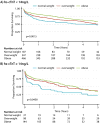Myocardial Injury, Obesity, and the Obesity Paradox: The ARIC Study
- PMID: 28017350
- PMCID: PMC5425302
- DOI: 10.1016/j.jchf.2016.10.010
Myocardial Injury, Obesity, and the Obesity Paradox: The ARIC Study
Abstract
Objectives: This study sought to determine whether pre-heart failure (HF) myocardial injury explains the differential mortality after HF across weight categories.
Background: Obesity is a risk factor for HF, but pre-HF obesity is associated with lower mortality after incident HF. High-sensitivity cardiac troponin T (hs-cTnT) is a sensitive marker of myocardial injury, and predicts incident HF and mortality.
Methods: Stratifying 1,279 individuals with incident HF hospitalizations by their pre-HF hs-cTnT levels (< and ≥ 14 ng/l), we examined the association of pre-HF body mass index (BMI) with mortality after incident HF hospitalization in the ARIC (Atherosclerosis Risk In Communities) study.
Results: Mean age at HF was 74 years (53% women, 27% black). Individuals with pre-HF hs-cTnT ≥14 ng/l had higher mortality after incident HF (hazard ratio [HR]: 1.46; 95% confidence interval [CI]: 1.18 to 1.80) compared to individuals with hs-cTnT <14 ng/l in an adjusted model including BMI. Compared with normal weight subjects, the mortality was lower in overweight (HR: 0.69, 95% CI 0.48-0.98) and obese individuals (HR: 0.50; 95% CI: 0.35 to 0.72) with hs-cTnT <14 ng/l; and in those with hs-cTnT ≥14 ng/l (overweight HR: 0.50; 95% CI: 0.30 to 0.83; obese HR: 0.56; 95% CI: 0.34 to 0.91; interaction: p = 0.154 between BMI and hs-cTnT). The lower mortality risk in obese and overweight subjects remained similar when log hs-cTnT was added as a continuous variable to a multivariable model, and in sensitivity analyses after further adjusting for left ventricular hypertrophy or high-sensitivity C-reactive protein.
Conclusion: Although greater pre-existing subclinical myocardial injury was associated with higher mortality after incident HF hospitalization, it did not explain the obesity paradox in HF, which was observed irrespective of subclinical myocardial injury. (Atherosclerosis Risk In Communities [ARIC]; NCT00005131).
Keywords: heart failure; myocardial injury; obesity paradox; outcomes.
Published by Elsevier Inc.
Figures



Comment in
-
Obesity and Survival With Heart Failure: Still a Paradox.JACC Heart Fail. 2017 Jan;5(1):64-66. doi: 10.1016/j.jchf.2016.11.011. JACC Heart Fail. 2017. PMID: 28034378 No abstract available.
Similar articles
-
Obesity, subclinical myocardial injury, and incident heart failure.JACC Heart Fail. 2014 Dec;2(6):600-7. doi: 10.1016/j.jchf.2014.05.017. Epub 2014 Oct 22. JACC Heart Fail. 2014. PMID: 25443112 Free PMC article.
-
Physical Activity, Obesity, and Subclinical Myocardial Damage.JACC Heart Fail. 2017 May;5(5):377-384. doi: 10.1016/j.jchf.2017.02.002. JACC Heart Fail. 2017. PMID: 28449797 Free PMC article.
-
Six-Year Change in High-Sensitivity Cardiac Troponin T and Risk of Subsequent Coronary Heart Disease, Heart Failure, and Death.JAMA Cardiol. 2016 Aug 1;1(5):519-28. doi: 10.1001/jamacardio.2016.0765. JAMA Cardiol. 2016. PMID: 27439107 Free PMC article.
-
High-Sensitivity Cardiac Troponin and New-Onset Heart Failure: A Systematic Review and Meta-Analysis of 67,063 Patients With 4,165 Incident Heart Failure Events.JACC Heart Fail. 2018 Mar;6(3):187-197. doi: 10.1016/j.jchf.2017.11.003. Epub 2018 Jan 10. JACC Heart Fail. 2018. PMID: 29331272
-
The paradox of obesity cardiomyopathy and the potential for weight loss as a therapy.Obes Rev. 2015 Aug;16(8):679-90. doi: 10.1111/obr.12292. Epub 2015 Jun 11. Obes Rev. 2015. PMID: 26096833 Review.
Cited by
-
The relationship between weight indices and injuries and mortalities caused by the motor vehicle accidents: a systematic review and meta-analysis.J Inj Violence Res. 2020 Jan;12(1):85-101. doi: 10.5249/jivr.v12i1.1198. Epub 2019 Dec 21. J Inj Violence Res. 2020. PMID: 31863576 Free PMC article.
-
Obesity paradox and heart failure.Eat Weight Disord. 2021 Aug;26(6):1697-1707. doi: 10.1007/s40519-020-00982-9. Epub 2020 Aug 26. Eat Weight Disord. 2021. PMID: 32851592 Review.
-
Current Status and Potential Therapeutic Strategies for Using Non-coding RNA to Treat Diabetic Cardiomyopathy.Front Physiol. 2021 Jan 22;11:612722. doi: 10.3389/fphys.2020.612722. eCollection 2020. Front Physiol. 2021. PMID: 33551838 Free PMC article. Review.
-
Morbidity, mortality, and obesity paradox.Ann Transl Med. 2017 Nov;5(21):440. doi: 10.21037/atm.2017.08.31. Ann Transl Med. 2017. PMID: 29201891 Free PMC article. No abstract available.
-
Malnutrition in acute heart failure with preserved ejection fraction: clinical correlates and prognostic implications.ESC Heart Fail. 2019 Oct;6(5):953-964. doi: 10.1002/ehf2.12501. Epub 2019 Aug 10. ESC Heart Fail. 2019. PMID: 31400092 Free PMC article.
References
-
- Mozaffarian D, Benjamin EJ, Go AS, et al. Heart Disease and Stroke Statistics-2015 Update: A Report From the American Heart Association. Circulation. 2014 - PubMed
-
- Kenchaiah S, Evans JC, Levy D, et al. Obesity and the risk of heart failure. The New England journal of medicine. 2002;347:305–13. - PubMed
-
- Lissin LW, Gauri AJ, Froelicher VF, Ghayoumi A, Myers J, Giacommini J. The prognostic value of body mass index and standard exercise testing in male veterans with congestive heart failure. Journal of cardiac failure. 2002;8:206–15. - PubMed
-
- Horwich TB, Fonarow GC, Hamilton MA, MacLellan WR, Woo MA, Tillisch JH. The relationship between obesity and mortality in patients with heart failure. Journal of the American College of Cardiology. 2001;38:789–95. - PubMed
Publication types
MeSH terms
Substances
Associated data
Grants and funding
- HHSN268201100012C/HL/NHLBI NIH HHS/United States
- HHSN268201100009I/HL/NHLBI NIH HHS/United States
- HHSN268201100010C/HL/NHLBI NIH HHS/United States
- HHSN268201100008C/HL/NHLBI NIH HHS/United States
- R01 DK089174/DK/NIDDK NIH HHS/United States
- HHSN268201100007C/HL/NHLBI NIH HHS/United States
- HHSN268201100011I/HL/NHLBI NIH HHS/United States
- HHSN268201100011C/HL/NHLBI NIH HHS/United States
- HHSN268201100006C/HL/NHLBI NIH HHS/United States
- T32 HL110837/HL/NHLBI NIH HHS/United States
- HHSN268201100007I/HL/NHLBI NIH HHS/United States
- HHSN268201100005G/HL/NHLBI NIH HHS/United States
- HHSN268201100008I/HL/NHLBI NIH HHS/United States
- HHSN268201100005I/HL/NHLBI NIH HHS/United States
- K24 DK106414/DK/NIDDK NIH HHS/United States
- HHSN268201100009C/HL/NHLBI NIH HHS/United States
- HHSN268201100005C/HL/NHLBI NIH HHS/United States
LinkOut - more resources
Full Text Sources
Other Literature Sources
Medical
Research Materials
Miscellaneous

